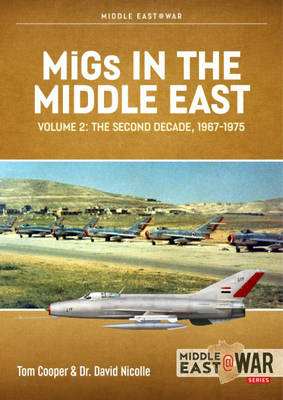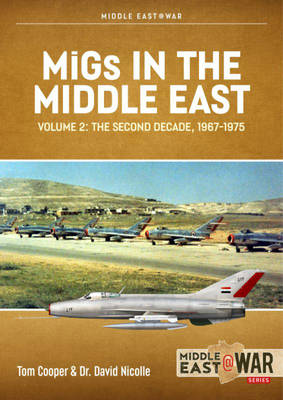
Je cadeautjes zeker op tijd in huis hebben voor de feestdagen? Kom langs in onze winkels en vind het perfecte geschenk!
- Afhalen na 1 uur in een winkel met voorraad
- Gratis thuislevering in België vanaf € 30
- Ruim aanbod met 7 miljoen producten
Je cadeautjes zeker op tijd in huis hebben voor de feestdagen? Kom langs in onze winkels en vind het perfecte geschenk!
- Afhalen na 1 uur in een winkel met voorraad
- Gratis thuislevering in België vanaf € 30
- Ruim aanbod met 7 miljoen producten
Zoeken
Migs in the Middle East
Volume 2 - Soviet-Designed Combat Aircraft in Egypt and Syria 1963-1967
David Nicolle, Tom Cooper
€ 27,95
+ 55 punten
Omschrijving
Hundreds of fighter-bombers of Soviet design and manufacture served in the air forces of multiple frontline Arab states during the first half of the 1960s. Not only older Mikoyan i Gurevich MiG-15s and MiG-17s, but also newer types such as the MiG-19 and MiG-21 were acquired in continuously increasing numbers, concurrently with Ilyushin Il-28- and Tupolev Tu-16 bombers, transport types such as the Antonov An-12 and Ilyushin Il-14, and trainers designed by Yakovlev. Nowhere else did they - and their pilots - play as important a role for the future of the local air forces - or entire nations - as in Egypt and Syria from 1963 until 1967. Whilst the period in question is still frequently described as a 'peaceful decade' in Israel and the West, they saw almost uninterrupted action: in Egypt, in Syria, as well as in Yemen, and especially in continuous incidents with Israel.
Based on official documentation and extensive interviews with dozens of veterans, and richly illustrated with exclusive photography and color profiles, MiGs in the Middle East Volume 2 is a uniquely compact yet comprehensive guide to the build-up and operational history of Soviet-made aircraft in Egypt and Syria during this period. Prepared by authors that have established themselves as top authorities on the Arab air forces, and supported by custom-drawn color profiles and detailed maps, it provides an exclusive, in-depth study and a single point of reference for the operational history of the Egyptian and Syrian air forces, their organization and markings of the mid-1960s.
Based on official documentation and extensive interviews with dozens of veterans, and richly illustrated with exclusive photography and color profiles, MiGs in the Middle East Volume 2 is a uniquely compact yet comprehensive guide to the build-up and operational history of Soviet-made aircraft in Egypt and Syria during this period. Prepared by authors that have established themselves as top authorities on the Arab air forces, and supported by custom-drawn color profiles and detailed maps, it provides an exclusive, in-depth study and a single point of reference for the operational history of the Egyptian and Syrian air forces, their organization and markings of the mid-1960s.
Specificaties
Betrokkenen
- Auteur(s):
- Uitgeverij:
Inhoud
- Aantal bladzijden:
- 80
- Taal:
- Engels
- Reeks:
Eigenschappen
- Productcode (EAN):
- 9781914059360
- Verschijningsdatum:
- 26/08/2021
- Uitvoering:
- Paperback
- Formaat:
- Trade paperback (VS)
- Afmetingen:
- 210 mm x 297 mm
- Gewicht:
- 299 g

Alleen bij Standaard Boekhandel
+ 55 punten op je klantenkaart van Standaard Boekhandel
Beoordelingen
We publiceren alleen reviews die voldoen aan de voorwaarden voor reviews. Bekijk onze voorwaarden voor reviews.









